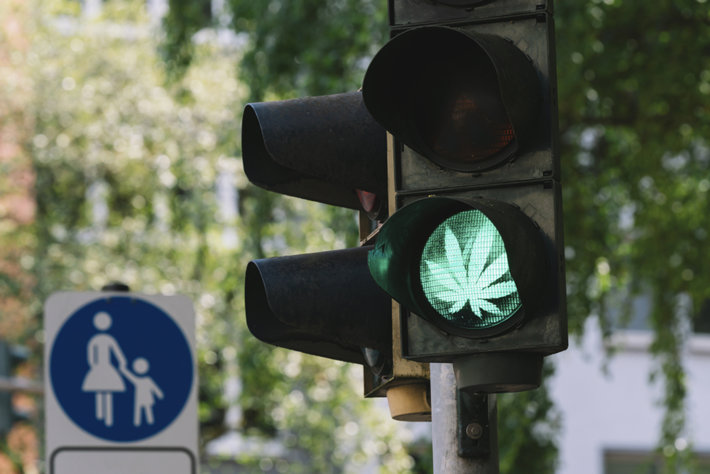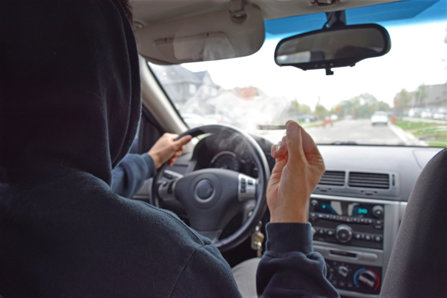Marijuana-Impaired Driving—A Growing Trend Just as Dangerous as Drunk Driving

What can we expect from the increasing legalization of marijuana? Logically, we can expect much of the same adverse circumstances that surround alcohol consumption. We can expect addiction to marijuana, we can expect far more people using cannabis-based drugs, we can expect a decrease and general downturn in socioeconomic and overall human welfare conditions in the United States.
One point of concern, in particular, is the steady increase in drugged-driving deaths that have come on the coattails of recent marijuana legalization. As marijuana becomes more prevalent in our society, it is presenting a similar problem to alcohol, with one key difference; there is no easy way to test drivers for being under the influence of marijuana. The result has been an increase in the cases of accidents caused by impaired driving due to drug use.
Research Data on Marijuana-Impaired Driving
The Columbia University’s Mailman School of Public Health, funded by the National Center for Injury Prevention and Control, published extensive research from 2013 and 2014 regarding driving accidents and fatalities where marijuana was involved. According to the research, the prevalence of marijuana in fatally injured drivers more than tripled from 1999 to 2010. Here are some of the exact figures:
- Using data gathered from the National Highway Traffic Safety Administration’s Fatality Analysis Reporting System, the Columbia University researchers were able to examine 23,591 people who died in car accidents.
- Of that number, 39.7 percent were found to have alcohol in their system in post-mortem toxicology reports. About 24.8 percent of them tested positive for drugs.
- From 1999 to 2010, the annual number of people who died in car accidents with alcohol in their system stayed about the same.
- However, the number of people who died every year in car accidents while also having drugs in their system increased over the period analyzed. In 1999, 16.6 percent of all traffic fatalities were individuals who had drugs in their system. In 2010, 24.8 percent were individuals who had drugs in their system.
- Of the individual drugs noted in the study, marijuana was the drug which increased in prevalence the most. In 1999, only 4.2 percent of traffic fatalities were individuals who had marijuana in their system. In 2010, that percentage increased to 12.2 percent—an almost three-fold increase.
This data is quite concerning to the experts, and it should be of concern to all of us. According to Dr. Guohua Li, MD, DrPH, professor of Epidemiology and Anesthesiology and the director of the Center for Injury Epidemiology and Prevention: “Given the increasing availability of marijuana and the ongoing opioid overdose epidemic, understanding the role of controlled substances in motor vehicle crashes is of significant public health importance.”
“… Although each of these states (California and Colorado) has laws that prohibit driving under the influence of marijuana, it is still conceivable that its decriminalization may result in increases in crashes involving marijuana.”
And according to Joanne Brady, a Mailman School Ph.D. candidate in epidemiology and the lead author of this particular study, “The marked increase in its (marijuana) prevalence as reported in the present study is likely germane to the growing decriminalization of marijuana. Although each of these states (California and Colorado) has laws that prohibit driving under the influence of marijuana, it is still conceivable that its decriminalization may result in increases in crashes involving marijuana.”
Further Research from the Governors Highway Safety Association
Another organization, the Governors Highway Safety Association, also studies fatality statistics for car accidents and what factors may have caused those accidents. Their data aligns with the information from Columbia University.
According to the report of the Governors Highway Safety Association, “The report found that among drug-tested fatally-injured drivers in 2016, 38% tested positive for some form of marijuana, 16% tested positive for opioids, and 4% tested positive for both marijuana and opioids. The publication also highlights the frequency of poly-drug use, or the use of multiple potentially-impairing substances simultaneously.”
Everywhere we look it seems, marijuana-impaired traffic fatalities are not only increasing, but they are surpassing other drugs and becoming the number-one drug found in such deaths. How long will it be before the number of annual marijuana-impaired traffic fatalities overtake drunk driving fatalities? That is the exact direction we are headed in if marijuana legalization continues to take place. That is the precise course of action we can expect if we don’t take massive action as a nation to address this issue.
Washington State and Marijuana-Impaired Driving

A study published in the Journal of Studies on Alcohol and Drugs and further discussed in a recent issue of U.S. News, points out increasing tends in marijuana-impaired driving among Washington State residents. (Marijuana consumption is legal for medicinal and recreational purposes in Washington State.)
In the Washington State study, roadside tests of 2,000 drivers found that 14% of drivers who had children in the car tested positive for THC. In contrast, only 0.2 percent of drivers with children in the car tested positive for alcohol.
We should note here that just because a driver has marijuana in their system does not mean they are under the influence. Trace elements of marijuana can stay in the body for quite some time. Still, the fact that 14% of drivers tested positive for THC is quite concerning.
In Conclusion
What we are seeing is an increase in marijuana-impaired driving, and the result of that has been quite harmful, causing deaths, accidents, and threats to children and other drivers, passengers, and pedestrians. We have to raise awareness of this. We have to make it clear that marijuana and driving don’t mix. People shouldn’t be consuming cannabis in the first place for a mountain of other reasons. And they absolutely should not be driving under the influence.
If you know someone who is using marijuana compulsively, the answer for them is to find help through a residential drug and alcohol addiction treatment center. But if you know someone who is using marijuana and who is driving while under the influence, they need to be thoroughly disabused of the idea that it is an “okay” thing to do. They are putting their own life at risk as well as risking the lives of others.
Sources:
- https://www.mailman.columbia.edu/public-health-now/news/signs-point-sharp-rise-drugged-driving-fatalities
- https://www.ghsa.org/resources/DUID18
- https://www.jsad.com/doi/full/10.15288/jsad.2019.80.196
- https://www.usnews.com/news/health-news/articles/2019-04-25/many-drivers-testing-positive-for-marijuana-even-with-kids-in-car
Reviewed by Claire Pinelli ICAADC, CCS, LADC, RAS, MCAP


